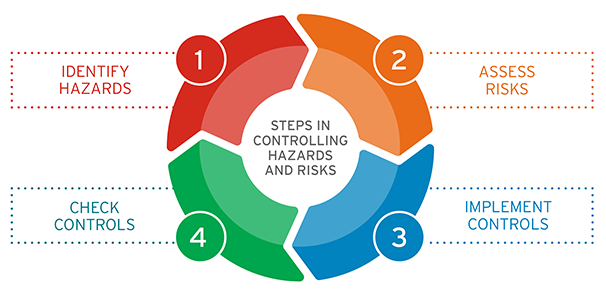On this page
Identify appropriate controls by understanding erosion and sediment hazards and risks
Follow a risk management process to help you understand and manage erosion and sediment hazards and risks from your business. You can learn how to follow a risk management process involving these steps:

Following a risk management process will also help you identify controls to put in place.
Put controls in place
Before you put controls in place, consider your approach to planning and site management.
For example, does your site layout help or hinder your control of hazards and risks? Do your business processes, systems and activities help you prevent harm?
The controls you decide to put in place will depend on:
- your business activities
- the nature of the erosion and sediment.
Preventing erosion is the best approach to reduce risk. You should also:
- minimise erosion (for example, through water management, wind reduction)
- manage sediment (for example, through capture, filtration).
Consider how you will use controls and how effective they will be before you select a control.
Controls need to be fit for purpose and installed and maintained correctly. For example, you can only use some controls in waterways. Some controls can only deal with coarse sediment and others only with fine sediment.
You may also need to seek more tailored advice from a suitably qualified person. This might involve engaging a consultant.
Examples of controls and things you can do to reduce erosion and sediment include:
- Manage soil disturbance (publication 1894).
- Use a treatment train (multiple control) approach (publication 1893).
- Slow wind or water flow rates, for example: rock armouring, baffling systems, erosion matting, wind fences and shelter belts.
- Perimeter structures to capture and manage sediment, for example: silt fences or barriers, check dams, coir logs and earth contour banks.
- Manage stockpiles (publication 1895).
- Manage truck and other vehicle movement (publication 1897).
- Manage how you work within or adjacent to waterways (publication 1896).
- Protect existing drainage systems, for example: using coir log filters, culvert gravel filters/rock logs, engineered drainage systems with flow slowing or load management measures.
- Manage off-site flows, for example: direct water around or away from exposed areas, stockpiles, embankments or sensitive receivers, downslope water diversions.
You can use other controls. But, you must be able to demonstrate you have eliminated or reduced the risk of harm as far as reasonably practicable.
The International Erosion Control Association – Australasia provides information and resources on erosion and sediment control, and their influences on air, land and water quality.
Resources to help you manage risk
International Erosion Control Association Australasia – Best Practice Erosion and Sediment Control
Melbourne Water – Treatment train
Read next
Erosion and sediment: advice for businesses
Reviewed 4 May 2021



